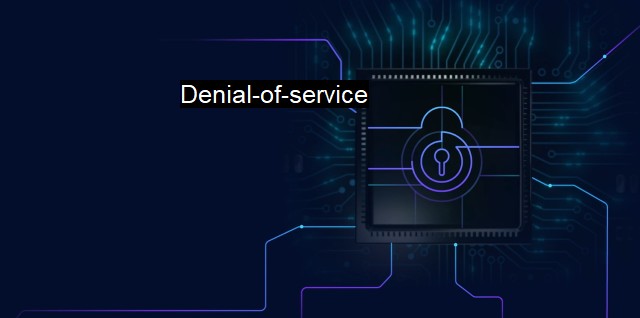What is Denial-of-service?
Understanding Denial-of-Service (DoS) Attacks: Impact and Prevention Measures
Denial-of-service, or DoS, is a well-known term in cybersecurity that refers to a set of attack methods targeting online systems, networks, or services with the purpose of making them unavailable for a short or long span of time. An attacker seeks to hinder or suspend the functioning of a website, service, or network by overwhelming it with a flood of useless traffic or sending information that triggers a system crash. denial-of-service stands as a modern threat that doesn’t aim at stealing useful information or data but targets the normal functionality of a system providing a service.Effectively, a DoS attaches a system's resources by sending more data than it can handle at once. In a standard scenario, the targeted system becomes preoccupied with processing an overload of nonsensical requests, which negatively impacts its ability to cater to legitimate customers or users. Consequently, a legitimate user trying to access the service during active attack may encounter difficulties in getting through or may end up facing a system shutdown, thereby disrupting their routine activities.
There are two types of DoS attack: simple DoS and Distributed Denial-of-Service (DDoS). In a simple DoS attack, one computer and one internet connection are used to instigate the attack, while in a DDoS attack, multiple computers and internet connections are used. A DDoS attack comes across as more lethal because the targeted resources are attacked from multiple points, thus making it almost impossible to stop instantly.
Considering that a majority of businesses, institutions, and industries today depend on the internet for their day-to-day operations, a successful DoS attack can result in significant operational disruptions and financial losses. The widespread adoption of digital technology systems across a multitude of sectors has emboldened the likelihood of these attacks, raising critical challenges for the cybersecurity sector.
While service denial may happen due to a myriad of technical downturns and does not necessarily imply an active attack, organizations must employ strict measures to prevent genuine attacks from this perspective. For this reason, antivirus software with advanced cybersecurity features becomes an essential tool for defense. Modern antivirus software packages won't just fend off typical viruses but also provide protection from diverse malicious exploits, cybersecurity threats including DoS and DDoS attacks.
The fundamental security advisory strategy against DoS attacks includes the utilization of robust firewalls and intrusion detection systems. Antivirus or security solutions that only look out for viruses won't work against DoS attacks. They only recognize the notorious signatures of known intrigue. A fortified firewall scrutinizes an incoming signal's frequency and denies service to questionable, voluminous traffic detected early.
Delaying and looping inbound signals can significantly diminish the DDoS threat as well. These defense tactics can potentially stress the hardware capacity of the attacker's system, thus stalling or discouraging them from pursuing the attack.
Configuring the operating systems to open fewer ports and close unattended ones can also amplify operating system security. Shielding your systems from phishing attacks, securing your routers, keeping your systems updated, and constantly monitoring your network for anomalies also rank among ideal steps toward undermining DoS attacks.
When social-economic activities on the cyberspace spur, the threat of DoS attacks increases proportionately, which betokens the essentiality of a vigilant surveillance strategy against such threats. Having robust network security protocols will help maneuver incidents of disruption from DoS attacks. With relevant security diligence, the effects of DoS and DDoS attacks can be curtailed, thus minimizing performance lags and service outages.

Denial-of-service FAQs
What is a denial-of-service attack?
A denial-of-service (DoS) attack is a type of cyber attack that seeks to make a website or network unavailable to its intended users by flooding the targeted system with traffic or sending it information that triggers a crash or malfunction.How does a denial-of-service attack work?
A denial-of-service attack typically involves overwhelming a server or network with traffic in order to prevent legitimate users from accessing the targeted resource. This can be accomplished by using a botnet - a network of compromised devices controlled by an attacker - to flood the system with traffic, or by exploiting vulnerabilities in the system to cause a crash or freeze.What can I do to protect against denial-of-service attacks?
There are several steps you can take to protect yourself against denial-of-service attacks. These include implementing strong firewalls and intrusion detection systems, keeping your software up-to-date with security patches, and regularly monitoring your network traffic for signs of anomalous activity. You can also work with a cybersecurity professional to develop a comprehensive security plan that takes into account your unique needs and risks.What role do antivirus programs play in preventing denial-of-service attacks?
Antivirus programs can play an important role in preventing denial-of-service attacks by detecting and neutralizing malware that can be used to launch these attacks. A good antivirus program will be able to quickly identify and quarantine malware on your system, preventing it from being used to launch a DoS attack. However, it's important to note that antivirus programs are not a silver bullet, and that a comprehensive cybersecurity strategy will need to include a range of different tools and techniques.| | A | | | B | | | C | | | D | | | E | | | F | | | G | | | H | | | I | | | J | | | K | | | L | | | M | |
| | N | | | O | | | P | | | Q | | | R | | | S | | | T | | | U | | | V | | | W | | | X | | | Y | | | Z | |
| | 1 | | | 2 | | | 3 | | | 4 | | | 7 | | | 8 | | |||||||